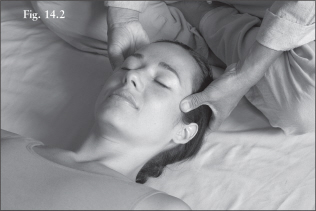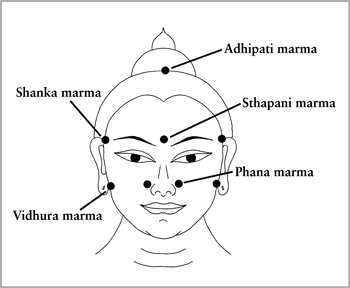
Session Closure
We conclude a Thai Yoga Massage session much like a yoga class—with the recipient lying on her back in Savasana. Now that the recipient is completely relaxed and full of renewed prana there is one last and much-loved movement to perform—a face massage! The facial techniques of a traditional Thai massage are chopping, squeezing, pinching, and slapping; however, ending a session this way shocks the body (and the mind) of most Western recipients. This is not a very relaxed way to end a massage.
Our approach to the session closure provides an alternative to the abrupt method commonly used in Thailand. We finish with a gentle rubbing and stroking of the facial muscles. By stimulating the nerves that govern the facial muscles we improve the tone of those muscles and prevent wrinkles, providing a natural face-lift.
Keeping with the tradition of working the marma points, we include light circulation of pressure points with the fingers. As you work on the facial points, visualize each one as an essential transfer station that passes vital energy to the sensory organs, nasal cavity, and brain. Encourage a free and peaceful flow of energy through each marma point.
When beginning the massage, move in slowly and gently with your hands so as not to startle the recipient. At the end, remove your hands slowly and gently. Before beginning the facial massage you may place a few drops of essential oil on your wrists to provide basic aromatherapy according to your client’s predominant dosha. (For a list of essential oils that correspond to each dosha, please refer to page 27.)
Following the face massage, finish the session as you began: with a moment of silence in Namaskar.
Sit close to the recipient’s head. Stroke the side of the recipient’s face in a soft and nurturing way (fig. 14.1). Press gently at the temples to stimulate the
Shanka marma and relieve any lingering tension at the head (fig. 14.2). Massage the ears, home to many acupressure points. Rub and squeeze the entire ear, giving special attention to the earlobes. Recipients generally love this! Finish by stroking the side of the recipient’s face again in preparation for the marma face massage.
Now begin to work the marma points by applying circular thumb pressure to stimulate all the facial marma points shown below. The only point that may be difficult to reach with the thumbs is the Vidhura point, below the ear, in which case you may use the index and middle fingers. Gently rub each point for approximately three to five breaths for a general massage.
Benefits: Provides a natural Ayurvedic face-lift; increases the flow of prana to the head, clearing the senses and mind.
Vayus activated: Prana, udana
Ayurvedic tip: Apply a few drops of essential oil on your wrist for Ayurvedic aromatherapy. For example, patchouli is good for vata, sandalwood benefits pitta, and eucalyptus is a good scent for kapha.



Now that you are at the end of your session with the recipient, it is important to have a formal approach for departure. This is particularly true when you embody Ayurvedic qualities that counterbalance your recipient. If we do not make a proper closure, our own doshic constitution may be influenced by our work.
In order to initiate this closure, sit behind the recipient, your hands together at your heart in the Namaskar prayer posture. Take a moment to empty your thoughts; be mindful of your breath and detach from the doshic approach you embodied. You may also use a pleasant-sounding bell or a soothing Om chant to return to a neutral state.
This moment of silence allows you to detach from the doshic quality embodied during the massage and center yourself according to your own doshic makeup. It also provides a quiet moment to reconnect with the true purpose of Ayurveda and Thai Yoga Therapy, to plant the seeds of loving-kindness and to cultivate metta in all that we do.